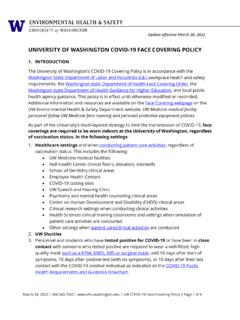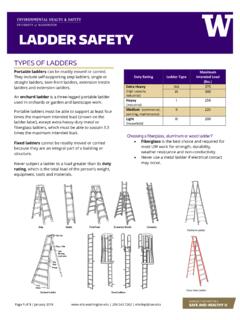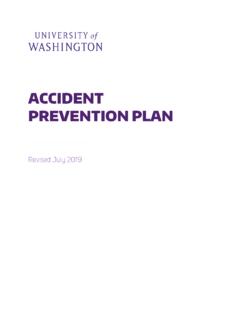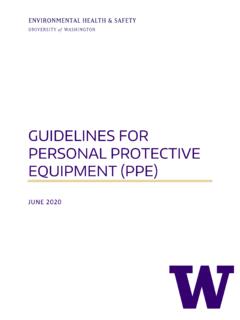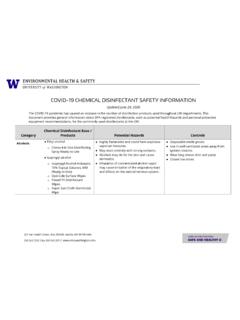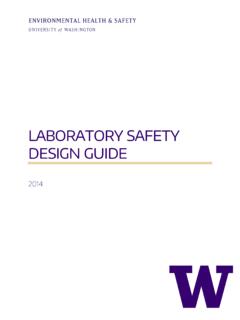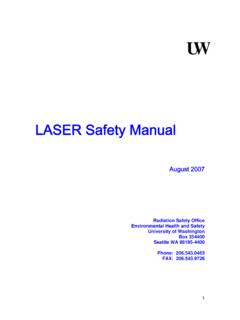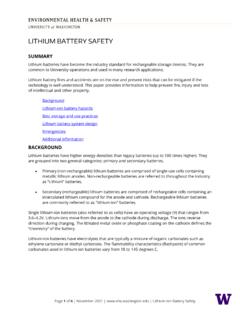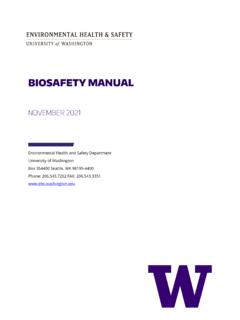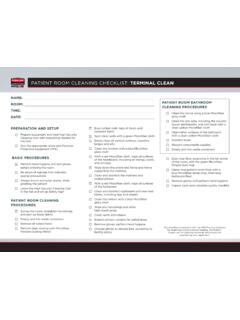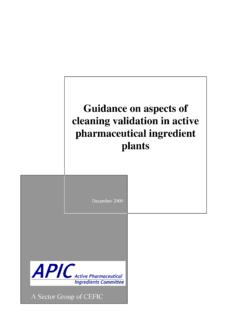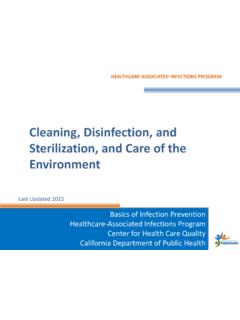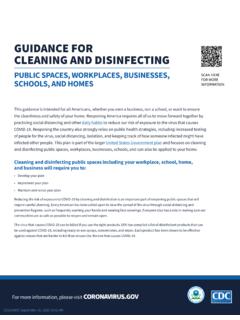Transcription of COVID-19 CLEANING AND DISINFECTION PROTOCOL
1 11/16/21 COVID-19 Prevention: CLEANING and DISINFECTION PROTOCOL Page 1 of 10 COVID-19 CLEANING AND DISINFECTION PROTOCOL November 16, 2021 1. INTRODUCTION The University is implementing this CLEANING and DISINFECTION PROTOCOL as an element of the University s COVID-19 Prevention Plan. While it is possible for people to be infected through contact with contaminated surfaces or objects, the risk of infection from touching a surface is low. Regular CLEANING and disinfecting surfaces can help reduce COVID-19 infection risk from surface contact, however, the most reliable way to prevent infection from surfaces is to regularly wash hands with soap and water. When handwashing is not a readily available option, use hand sanitizer. This PROTOCOL was developed by the University s Environmental Health & Safety Department (EH&S) in coordination with campus custodial and instructional support units and the University s Advisory Committee on Communicable Diseases (ACCD).
2 This PROTOCOL reflects requirements and guidelines set forth by the Washington State Department of Labor and Industries, the Centers for Disease Control and Prevention (CDC), and the Washington State Proclamation 20-12 for Higher Education. Appendix Table 1 at the end of this PROTOCOL summarizes the recommended CLEANING and DISINFECTION guidelines, frequencies, and roles for various spaces at the University. University medical center facilities follow additional procedures for health care settings. University youth and childcare settings follow the additional Washington State Department of Health guidance for K-12 and child care, youth development and day camps. 2. GENERAL The University conducts regular CLEANING and DISINFECTION for COVID-19 prevention in UW owned and leased facilities, focusing on high touch surfaces in public and common areas, such as residence hall communal rooms, public restrooms, lobbies, classrooms, auditoriums, dining establishments, and libraries.
3 Appendix Table 1 outlines the typical spaces and surfaces requiring CLEANING and DISINFECTION at the University, roles and responsibilities for custodial staff and users of the spaces, and the minimum recommended frequency for CLEANING and DISINFECTION in these areas. Frequency CLEANING of high-touch surfaces must be done at least once a day, and when visibly dirty. High touch surfaces can include tables, handrails, faucets, doorknobs, light switches, kitchen appliances, drinking fountains, and shared equipment and computer workstations ( , monitors, keyboards, mouse). Disinfecting can be done as a secondary step on high-touch surfaces. 11/16/21 COVID-19 Prevention: CLEANING and DISINFECTION PROTOCOL Page 2 of 10 Definitions The definitions for CLEANING and DISINFECTION are described below: CLEANING removes most germs, as well as dirt and debris from surfaces or objects. CLEANING works by using soap (or detergent) and water to physically degrade and remove most germs from surfaces.
4 This process does not necessarily kill all germs, but it significantly lowers their numbers on surfaces and the risk of spreading infection. The outer membrane of SARS-CoV-2, the virus that causes COVID-19 , can be physically degraded by surfactants contained in all EPA-approved CLEANING agents. Disinfecting kills (or inactivates) germs on surfaces or objects. Disinfecting works by using chemicals to kill or inactivate germs on surfaces or objects. This process does not necessarily clean dirty surfaces or remove germs, but by killing remaining germs on a surface after CLEANING , it can further lower the risk of spreading infection. 3. CLEANING AND DISINFECTING SURFACES AND EQUIPMENT A. Use of Environmental Protection Agency (EPA) registered disinfectants reduces the potential risk of surface transmission by inactivating remaining germs (including SARS-CoV-2 virus particles) on surfaces. Refer to the American Chemistry Council (ACC) list of Novel Coronavirus ( COVID-19 ) Fighting Products, or the EPA list of registered disinfectants approved for use against the SARS-CoV-2 virus.
5 DISINFECTION may be required if a COVID-19 positive individual has spent time recently in an area. B. Follow the manufacturer s instructions for safe and effective use of all CLEANING and DISINFECTION products ( , dilution concentration, application method and contact time, required ventilation, and use of personal protective equipment). I. The disinfectant concentrations and contact time are critical for effective DISINFECTION of surfaces. II. Ensure that disinfectants are prepared in well-ventilated areas and handled safely, while wearing the appropriate personal protective equipment (PPE) to avoid chemical exposures. III. Review the EH&S COVID-19 Chemical Disinfectant Safety Information guide for recommended safety measures for common DISINFECTION agents. C. Electronics ( , tablets, touch screens, keyboards, lab, or office equipment with sensitive electronic components): Follow the manufacturer s instructions and recommendations for CLEANING the equipment or electronic device.
6 Consider putting a wipeable cover on electronics, which makes CLEANING and disinfecting easier. For equipment that cannot be easily sanitized, consider dedicating one user per equipment, changing disposable covers between users, or rotating the 11/16/21 COVID-19 Prevention: CLEANING and DISINFECTION PROTOCOL Page 3 of 10 equipment out so it sits unused for a couple of days between users. For electronic surfaces that need to be disinfected, use a product on the EPA list that meets manufacturer s recommendations. Many of the products for electronics and equipment containing sensitive electronic components are alcohol-based because it dries quickly. D. For DISINFECTION of hard, non-porous surfaces: i. Use a product listed on the American Chemistry Council (ACC) list of Novel Coronavirus ( COVID-19 ) Fighting Products, or select from the EPA list of registered disinfectants for use against the SARS-CoV-2 virus.
7 II. If using bleach, use a freshly prepared diluted bleach solution. iii. Alcohol is commonly used in labs. A solution with at least 70% alcohol can be used for surface DISINFECTION . Alcohol is a flammable liquid and should not be stored near ignition sources. Store flammable liquids appropriately according to fire safety practices (see Section 4 of the Flammable Liquids Standard Operating Procedure). E. For soft (porous) surfaces such as carpeted floor, rugs, and fabric chairs: i. Clean the surface using a product containing soap, detergent, or an appropriate cleaner indicated for use on these surfaces. ii. After CLEANING , launder items (as appropriate) in accordance with the manufacturer s instructions. Use the warmest appropriate water setting and dry items completely. iii. If laundering is not possible, use an EPA registered disinfectant approved for use against SARS-CoV-2 or refer to the list of American Chemistry Council (ACC) Novel Coronavirus ( COVID-19 Fighting Products.)
8 4. SAFETY GUIDELINES DURING CLEANING AND DISINFECTION A. Wear disposable gloves when CLEANING and disinfecting. Gloves should be discarded after each use. Clean hands immediately after gloves are removed. B. Wear eye protection when there is a potential for splash or splatter to the face. Wear a surgical mask (rather than a cloth mask) if there is a potential for splash or splatter to the face. C. For larger scale or frequent CLEANING ( , a large surface area), gowns or aprons are recommended to protect personal clothing. When applying CLEANING or disinfecting agents with electrostatic sprayers ( , over large or hard to reach areas) follow additional safety precautions in accordance with the Electrostatic Sprayers Focus Sheet. 11/16/21 COVID-19 Prevention: CLEANING and DISINFECTION PROTOCOL Page 4 of 10 D. Store disinfectants in labeled, closed containers. If dispensing disinfectants into secondary containers ( , spray bottles), these must also be labeled with their contents and hazards.
9 Keep them in a secure area away from children and food. Store them in a manner that prevents tipping or spilling. E. Add disinfectants to your MyChem inventory. 5. RESPONSE TO NOTIFICATION OF A COVID-19 POSITIVE INDIVIDUAL This PROTOCOL is for evaluation of CLEANING and DISINFECTION of areas where an individual with COVID-19 spent time (longer than 10 minutes) in a University space while potentially infectious to others. It is applied from 48 hours prior to the onset of symptoms until three days have passed since the individual was present in a University space. After EH&S receives notification that an individual with confirmed COVID-19 spent time at a UW location, the specific rooms and areas where the COVID-19 positive individual spent time will be assessed on a case-by-case basis. The determination of whether additional DISINFECTION and/or CLEANING will occur, and the scope of DISINFECTION and/or CLEANING is based on the risk of potential contamination as determined by EH&S, in coordination with the impacted units involved in the case follow-up, as needed.
10 The following steps include: A. EH&S, in coordination with the COVID-19 positive individual and the impacted unit, will identify all University locations where the individual spent longer than 10 minutes. B. EH&S and the impacted unit, in coordination with the custodial unit, will identify any locations that require additional DISINFECTION and /or CLEANING based on an assessment of the following information: i. Date(s) and duration of time spent in location(s) that have not already been cleaned and disinfected since the last time the individual was in the space ii. Frequency of CLEANING and/or DISINFECTION for identified location(s) iii. Date of onset of symptoms and/or date of positive test results iv. Activities conducted in the space(s) v. Face coverings and personal protective equipment worn by the COVID-19 positive individual C. EH&S, in coordination with the impacted unit and the custodial services unit, will determine roles and scope for additional DISINFECTION and/or CLEANING of spaces and equipment following the guidance outlined in this document.
